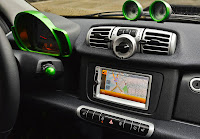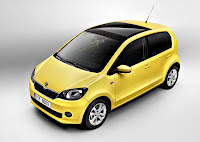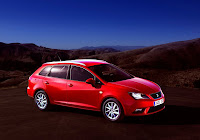








Taking all its different generations into account, Renault Clio stands out as one of Renault's best-selling cars, as well as a market benchmark that has generated total sales of almost 12 million cars since 1990. Today, Renault has capitalised on the model's hallmark strengths and everyday versatility to deliver New Clio which seeks to win over customers thanks to its attractive blend of emotion and solid core strengths.
New Renault Clio also champions Renault's new design identity which places the emphasis on simplicity, warmth and sensuality.
Thanks to the availability of two systems, including the introduction of Renault R-Link, New Renault Clio breaks new ground in the world of automotive multimedia. it also delivers a high standard of comfort and safety equipment across the range and features an affordable personalisation programme on an unprecedented scale for Renault.
New Clio's versatility is founded on even more efficient road holding and enhanced travelling comfort, while power is provided by a choice of engines that show the way forward in terms of low fuel consumption and CO2 emissions. the range includes a diesel powerplant which returns an unbeatable 3.2 litres/100km and 83g of CO2/km.
Meanwhile, New Renault Clio boasts a spacious cabin and a particularly big boot (300dm3). it is also rigorously designed, targets the highest possible level of active and passive safety (5 stars euro NCAP new rating) and is built to Renault's exacting quality standards.
Buoyed by the passion of the teams behind its design, New Clio, like its predecessor, continues to pack features that are normally only associated with larger cars and responds to market demands in a rational, yet emotional way.
The hatchback version of New Clio will go on sale in October 2012, while Clio Estate and Clio RS are scheduled to follow in the first quarter of 2013.
New Clio: an incarnation of Renault's new design identity
New Renault Clio is the first production model to give full expression to the Renault design renaissance inspired by Laurens van den Acker. the objective was to take the style and emotion of the brand's concept cars and carry them over to production models. New Clio meets that goal.
New Clio is instantly recognisable thanks to its front-end styling which features a prominent Renault logo, set bold and upright against a gloss black background, a signature first seen on the DeZir concept car. This frontal treatment is made more distinctive still by the headlights units, which include chrome details, and LED daytime running lights.
Available exclusively in five-door form, New Renault Clio has a sporty silhouette, accentuated by the integrated rear door handles concealed close to the rear quarter lights.
New Renault Clio will be available from launch in a choice of eight body colours, four of which are new. One of these is the distinctive launch colour, Flame Red, which takes its inspiration from the DeZir concept car.
Balanced, dynamic exterior proportions which express sportiness and confidence
Renault designers paid particularly careful attention to achieving balanced proportions for New Clio. Standing at 4,062mm in length, 1,732mm wide (excluding mirrors) and 1,448mm tall, it sits 45mm closer to the ground than its predecessor. Meanwhile, the front and rear track have been significantly widened (by between 34 and 36mm).
The lower ride-height ensures an assertive stance which is also beneficial to the car's aerodynamics. pronounced shoulder lines make New Renault Clio visually distinctive.
New Clio's coupé-like silhouette is accentuated by the integrated rear door handles concealed close to the rear quarter lights.
The ratio of wheel-size to vehicle-height has been fine-tuned for a more dynamic look. The large-diameter wheels are pushed 15mm outwards compared with Clio III in order to fill and finish flush with the wheel arches. A steeply raked windscreen adds to this dynamic feel, as does the improved glass / body ratio when New Clio is seen from the side (one-third and two-thirds respectively).
A modern, welcoming, occupant-friendly interior
The desire to combine beauty with functionality shows through clearly in numerous aspects of the interior design, from the dashboard in the shape of an aircraft wing, to the neat packaging of the multimedia systems in the centre console, the availability of stowage space throughout the cabin and careful attention to detail. The wide choice of colours and the use of chrome and gloss-black highlighting add to the warmth exuded by the cabin.
New Clio's range of easily distinguishable equipment levels and interior trims provides customers with a choice of inspiring, exciting and status-enhancing ambiences.
A choice of finishes, each with its own personality
Each of the New Clio range's equipment levels and trims has its own personality and ambience. The quality of the design and materials (e.g. colour inserts in the upholstery) is apparent even in the case of the extensively-equipped entry-level version (height- and reachadjustable steering wheel, 60/40-split folding rear bench seat, electric front windows and mirrors, plus keyless entry and ignition - all of which are standard across the range).
A lavishly-appointed, range-topping 'initiale paris' version will be added in 2013.
The exact specification and name of the different equipment levels will differ in some of New Clio's markets.
A personalisation programme covering core-range versions
Both inside and outside, New Clio was designed from the very beginning to take personalisation to a new level, from the steering wheel to the side protection mouldings. there are countless combinations and buyers will be able to select a specific character for their New Clio based around one of the three decor themes: 'trendy', 'sport' or 'elegant'. there is something for every budget, while personalisation features are fitted at the factory and available for the best-selling versions.
Original and "Unmistakably Renault"
The personalisation programme is structured around three distinct decor themes ('Elegant', 'Sport' and 'Trendy'), plus a selection of configurations based on a careful match between body colour and the dominant colour of the graphics and wheels.
The personalisation programme features:
Five exterior decor packs to enhance different areas of the body with chrome or colour trims.
Three different roof graphics.
A choice of two colours for the 16-inch diamond-effect wheels and a choice of the 17-inch diamond-effect wheels.
Seven interior decor packs which highlight different parts of the cabin with colours or motifs.
Four interior ambience packs which co-ordinate the colour of the dashboard colour with that of the upholstery and door panels.
For the exterior:
Exterior decoration elements are available in five different finishes: Chrome, black, Red, blue and Ivory. These finishes concern the grille, rear hatch and side protective moulding trims. In addition, the door mirror housings, rear bumper apron and side protective mouldings are picked out in gloss black lacquer.
The roof graphics come in a choice of three different themes: 'Elegant', 'Sport' or 'Trendy'.
The 16-inch diamond-effect 'Passion' wheels are available in a choice of two colours: Black or ivory.
The 17-inch diamond-effect 'Drenalic' wheels will be available from November 2012 in a choice of our colours: Black, red, Blue or ivory.
For the interior:
Interior gloss colour touches are available in a choice of four colours (black, Red, blue, or Ivory) and echo the same three themes as the exterior graphics ('Elegant', 'Sport' and 'Trendy'). These highlights concern the steering wheel, door panels, gear lever surround and air vent surrounds and are directly incorporated using a technique known as insert moulding.
In the case of the Dynamique equipment level, customers can choose from four colours for the interior ambience (black, Red, blue or Havana). These colours apply to the dashboard trim strip and door panels, with a matching colour for the upholstery fabric. A finishing touch for each ambience comes in the form of colour co-ordinated carpet mats, available as accessories.
Purposely designed
The personalisation programme emphasises New Clio's assertive character. From the very start of the project, areas lending themselves to highlighting were incorporated into the model's design. Meanwhile, quality is assured by the fact that features are assembled at the factory.
Affordable and versatile
New Clio's personalisation programme means that made-to-measure looks are now available for a versatile five-door family car. The programme covers all the different engine variants and the best-selling versions, making it an affordable reality for the bulk of the model's customers.
Create and share your favourite Clio
Examples of Clios personalised with off-the-shelf configurations will be on display at dealerships from launch date to show customers the scope of possibilities opened up by the three different personalisation themes.
A dedicated website provides a taste of the range of personalisation possibilities available for New Clio. Web users can configure and view their ideal New Clio.
Packed with innovations
New Renault Clio is poised to shake up the market by bringing a number of technological innovations to a much wider audience. true to tradition, it also establishes a new benchmark for its class in terms of its performance and equipment packages. On the multimedia front, New Renault Clio packs an unprecedented double punch for this level of range, while audio quality has been boosted by the introduction of the Renault Bass reflex system, not to mention the availability of a reversing camera among the long list of equipment...
Advanced Bluetooth® radio from the entry level version
New Renault Clio features a range of Bluetooth® radios with audio streaming. Occupants can enjoy music stored on portable players and also benefit from hands-free use of their telephone. The radio has access to numbers stored on the driver's cell phone (depending on telephone), while the car is equipped with its own microphone. sound processing quality has been optimised and all radios come with a jack socket and a UsB port to charge and scroll through the menus of portable music players and cell phones.
Media Nav: essential multimedia functions
New Renault Clio proposes a choice of all-new multimedia solutions. built into the centre console, the Media Nav system provides all the basic multimedia functions and is standard equipment for two of the model's three equipment levels. Thanks to its seven-inch (18cm) touchscreen display, it is intuitive to use and, in addition to the radio, includes Bluetooth® connectivity for audio streaming and hands-free telephony. Portable music players can be connected via the fasciamounted USb port or jack socket. Media Nav also incorporates Nav N Go navigation with 2D and 3D (birdview) display. The UsB port and a dedicated web interface make it easy to update NAVTEQ maps.
Renault R-Link: an integrated tablet connected to the car and the Internet
Having been first on the market with notable innovations such as steering wheel-mounted remote control of the radio (1982, R11 Electronic) and in-car navigation (1994, Safrane); after bringing keyless entry to volume cars (in 2001) and GPS navigation with high-resolution graphics (Carminat TomTom®, priced at under €500 for Clio in 2009); and having launched on-board connected navigation in the shape of Carminat TomTom® LIVE for Clio, Renault continues its stream of innovations with Renault R-Link.
Available as an option for New Clio, Renault R-Link will certainly appeal to technically-minded motorists and provides a bridge between the vehicle and the connected world outside thanks to:
A large seven-inch (18 cm) touchscreen display, intuitive voice commands and, a market first, a home page that can be personalised by the user for safe, simple access to key functions, without the driver having to take his or her eyes off the road.
A menu with six icons which provide access to the six main functions: Navigation, Multimedia, Phone, Vehicle, Services and Applications, and System.
TomTom® connected navigation including LIVE services: the market's best real-time traffic information service, minimisation of journey times and fuel consumption, plus Coyote Series alerts.
A connection with the car's own electronic systems permits access to an advanced eco-driving function (Driving eco²) which analyses the driver's behaviour and provides advice to help reduce fuel consumption.
Renault R-Link store, the automobile world's first ever evolving Application Store. Users can easily view or download a comprehensive selection of apps from their car or computer (via 'MyRenault').
Key functions and information available on the centre console
Renault R-Link's user-friendly seven-inch (18cm) touchscreen display forms an integral part of the modern centre console and provides a full range of multimedia functions (navigation, radio, bluetooth® telephony and audio-streaming, connectivity for portable music players, connected services, 'eco' driving, etc.) in one place for maximum comfort and enjoyment.
Renault R-Link ensures that information is available as and when it is needed, thereby avoiding the driver having to take his or her eyes off the road. Renault R-Link's touchscreen display permits fingertip control which doubles up with the steering wheel-mounted remote controls for the audio and telephone functions. Renault R-Link can also be controlled using intuitive voice commands to dictate the address of a destination for navigation purposes, for example, or to call up different functions using instructions such as 'telephone', 'apps', 'send an e-mail', etc. This facility makes use of the system even more practical and safer. The Text To Speech function (TTS) permits messages or RSS feeds to be read out loud.
R-Link apps cover a wide range of useful functions:
Communication: e-mails, social networking, web navigation, etc.
Journey optimisation: TomTom® LIVE services (HD Traffic®, speed control warnings [where authorised], TomTom Places, weather forecasts, Coyote Series alerts [where available], fuel prices, location of parking places, etc.).
Practical information: personal phone numbers, Yellow Pages, hotels, restaurants, etc.
Mobility: multi-mode journey planning, public transport.
Budget guides: 'by-the-kilometre' insurance, Renault tips, etc.
Vehicle information: monitoring of vehicle servicing, owner manual, etc.
Entertainment and leisure: games, information, travel information, engine sound profile, personalisation, etc.
Professional use: Fleet Managers will benefit from services for their business needs thanks to the vehicle connections
The apps developed for Renault R-Link are adapted for use by motorists, either by ensuring they are simple to use or by restricting access to certain functions while on the move. For example, functions which are overly interactive or long to use may only be used when the vehicle is at a standstill.
The catalogue of apps will cover a large spectrum of uses, extending from journey optimisation (TomTom LIVE services, fuel prices, location of parking places) and vehicle information (the monitoring of servicing, etc.), to budget guides ('by-the-kilometre' insurance, Renault tips, etc.), practical help (phone numbers, Yellow Pages, etc.), communications (e-mails, social networking, R-Tweet app) and entertainment/leisure (travel information, etc.) and emergency calls.
Renault's intention is to make R-Link store the benchmark automotive app store. To achieve this, it has favoured an open innovation strategy founded on input from major partners and development companies, as well as from start-ups which are brimming over with exciting ideas in the field of connected services and apps for automotive use. Partners in France include Pages Jaunes, La Poste, I-Dispo, Elle, balumpa, Michelin, Falk, Métro, Euronews, La Fourchette, Apila and NavX.
3D Sound by Arkamys®
All versions of New Renault Clio equipped with R-Link also benefit from 3D sound by Arkamys®. Thanks to special digital signal processing software, this system adds depth and texture to listening pleasure thanks to spatial positioning of the sound. Drivers can select where sound is to be directed in the cabin: for their ears only, for front occupants only or for all occupants.
Plus basic multimedia functions
To cater for the rapidly expanding use of portable music players, R-Link is equipped with bluetooth® audio and telephony connectivity, as well as a USB port and a jack input.
Bringing innovation to the widest possible audience
For enhanced safety and driving pleasure, nearly all the engines available for New Renault Clio incorporate hill start assist. When the driver lifts his or her foot from the brake pedal on a slope, the system - which is connected to the ESC - holds the vehicle stationary for two seconds, allowing the driver to pull away without the vehicle moving backwards. Every version of New Clio is equipped with esC, Asr traction control, ABs and emergency brake assist, as well as more direct variablerate electric power steering which ensures a level of agility that is particularly appreciable in built-up areas.
The standard equipment list also includes cruise control with speed limiter, while New Clio comes with 'motorway-mode' indicators, an extremely practical feature which produces three flashes of the indicator when preparing to overtake by lightly moving the indicator stalk.
Practical
New Renault Clio is an entirely keyless car. The key is replaced by an electronic card (depending on equipment level) which locks and unlocks the doors and permits the engine to be started without the driver removing the card from his or her pocket, bag, wallet, etc.
All versions of New Clio come with a height - and reach - adjustable steering wheel.
The long list of standard equipment is rounded off by electric, heated door mirrors, and electric front windows.
New Clio occupants benefit from plenty of practical stowage space located throughout the cabin:
A tray in front of the gear lever which can hold items like a portable music player, mobile phone or portable CD player.
A large seven-litre glove box capable of containing a 1.5-litre bottle of water.
A 1.2-litre tray situated above the glove box.
Two easy-to-access cup holders and additional stowage for small items between the seats at the foot of the centre console.
Storage in the optional central armrest (almost one litre).
Bins in each door designed to contain a 1.5-litre bottle of water.
A single switch allows all the windows of New Renault Clio to be demisted at the same time, while the climate control system has been improved to run even more quietly and more efficiently than that of Clio III.
























































